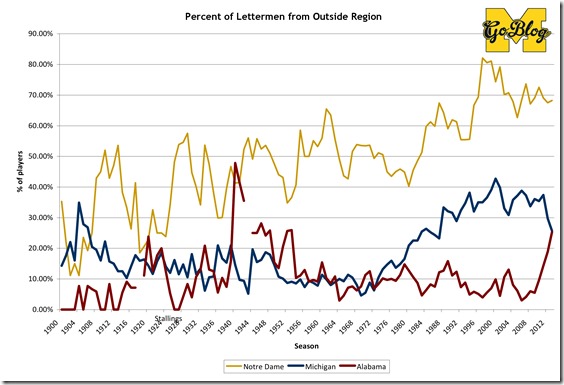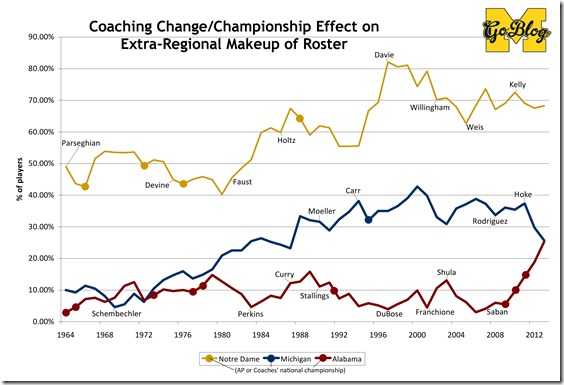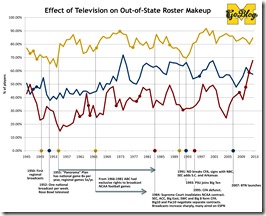Last week I started playing with Lemming's recruiting information to see how national recruiting had changed over the last few decades. Too late for that article I realized I could actually take this study back more than a century using lists of historical lettermen published by various teams in their annual media guides. Using the same regional breakdown I tried to get data for the same six I used in the old decimated defense series—Michigan, MSU, Ohio State, Penn State, Notre Dame, and Alabama—but only three had accessible info.
These are based on letterwinners, not entire rosters, so scholarship freshmen on the scout team aren't counted. It still gives us a picture:
Vestibulum ut maior
First the goofy things. The breaks in Alabama's lines are 1919 and 1943, when the Tide didn't field teams because too many players were fighting World Wars I and II, respectively. That big spike for Bama right before WWII is because they were used as an officers training base just prior to the war. Michigan got this same temporary—by 1943 those officers had shipped overseas—bump, but not as many registered since most came from the Midwest (e.g. Elroy "Crazy Legs" Hirsch from Wisconsin).
Second the obvious things. Notre Dame's claim to be a "national" program is defended by the data. From the 1920s through the '70s their teams were fielded from between 30% and 60% by players from outside of the Great Lakes States (plus Iowa). Since the '80s about 65% is the new normal. Michigan and Alabama tracked pretty similarly as major state schools who kept to their home regions up until Bo arrived. Beginning in 1969 Michigan began a trend upward that finally settled over 30% of players from outside their region. Alabama remained a predominantly regional program until Nick Saban arrived.
I zoomed in on the years since 1964 so we can better appreciate how coaching changes affected the programs:
Tangere facere magnum
Ewww don't touch me. I trust you know who Michigan's and Alabama's coaches were in 1964. The late '60s were the last time Michigan was as regional as Alabama. That now seems in danger of happening again. Last year Michigan dipped to 25.67% and Bama peaked at 25.33%.
Michigan graduated five players from outside the Midwest (Dileo, Gallon, Gibbons, Lewan, and Qwash), and two more (Ash and Furman) aren't returning for fifth years, but they brought in nine this year (Peppers, JBB, Winovich, Pallante, Watson, Speight, Mone, Cole and Canteen) so I expect their total to climb a little for 2014. It's too hard to say what Bama's number will be since they still need to cut 10 or 11 players before fall.
Championships win defense. Carr's 1997 championship, Parseghian's 1966 one, and Saban's 2009 title were all followed by steep increases in national recruiting; of the 14 titles in that chart two (Holtz's in 1988 and Stallings's in 1992) were accompanied by drops in the % of roster made up of extra-regional players. Michigan's historical peak is 2000, three years after their only TV-era national championship and one year after their Orange Bowl victory. The great Hoke classes of the last two years were very local.
[After the jump, I test another culprit]
The following charts (click makes bigger) show the out-of-region and out-of-state makeup of these three teams' rosters since 1945, with key dates in college football broadcast history included. For Notre Dame I counted both Indiana and Illinois as "in-state" since Chicago is really their home territory.
(I forgot to stick the national championships on the first one)
I don't think it's much of a stretch to suggest that the reach of a team's television audience affects the reach of their recruiting. Apparent success of a program and how often it appears on national broadcasts are probably related (that data would be nice to have), and that accounts for those big swings you see in the in-state makeup of these rosters. Those data in table format:
| % Out of State | % Out of Region | ||||||
|---|---|---|---|---|---|---|---|
| Period | Michigan | Notre Dame | Alabama | Michigan | Notre Dame | Alabama | |
| 1900-'13 | 46% | 64% | 4% | 20% | 35% | 3% | |
| 1914-'23 | 38% | 63% | 17% | 15% | 28% | 13% | |
| 1924-'33 | 40% | 75% | 28% | 13% | 45% | 8% | |
| 1934-'43 | 44% | 64% | 54% | 14% | 41% | 22% | |
| 1944-'53 | 46% | 71% | 35% | 14% | 48% | 22% | |
| 1954-'63 | 43% | 78% | 25% | 10% | 55% | 11% | |
| 1964-'73 | 50% | 84% | 36% | 9% | 51% | 8% | |
| 1974-'83 | 60% | 81% | 40% | 18% | 46% | 10% | |
| 1984-'93 | 63% | 78% | 37% | 29% | 61% | 10% | |
| 1994-'03 | 60% | 84% | 40% | 37% | 73% | 7% | |
| 2004-'13 | 56% | 84% | 44% | 35% | 69% | 11% | |
The big moments I counted:
Early 1950s: It took awhile for them to sort out how they would handle TV rights during a time when most households didn't have a TV yet. The NCAA was worried people would watch TV instead of go to the games and wanted to limit broadcasts. Notre Dame struck out on its own at first. You see a downward trend for all three schools in out-of-state and out-of-region roster makeup; I would guess that isn't television so much as what was going on with the walk-ons, as out-of-towners there for officer training school were replaced by a flood of local doughboys from the G.I. Bill.
 |
| I wish I had data for Michigan State so we could see how integration affected the Northern schools who'd grown rich off what the South wouldn't recruit. |
1955-'84 The Panorama Plan. Starting in the mid-'50s you can see Notre Dame leap up and maintain high level of non-Midwest players while the two big state schools remained relatively flat. Under the Panorama Plan there was only one game per week you could watch on TV—five weeks that was your regional game and eight weeks that was the one national broadcast. Notre Dame had a big advantage there in being a regularly strong national draw. As Bear Bryant's program (which he took over in '58) improved they became a regular national game too; while this didn't draw many kids from around the country, you can see the effect it had on getting kids from elsewhere in the fertile Southeast.
1984: The Supreme Court breaks up the NCAA's grip, and flood of new games get on TV. The Big Ten and Pac Ten were winners, though Michigan seems to have dipped a little as other schools in the Big Ten began to catch up in broadcasts. Note that this didn't seem to change anybody's out-of-state numbers but Michigan and Notre Dame were both getting significantly more kids from around the country.
1990s and aughts: Once ND signed their NBC contract they had a very sharp and permanent increase in national draw. Since ABC/ESPN would make their biggest games into national broadcasts, Michigan got a national bump whenever it was good.
2010s: Recently the trend has been backsliding toward more games put into less accessible cable tiers. There's hardly enough data yet to support it, let alone to separate it from Michigan's national cachet, but I would guess BTN overall has hurt Michigan's national appeal, since much of the country doesn't have BTN. I don't fault Notre Dame, considering how national their roster is, for staying away.



